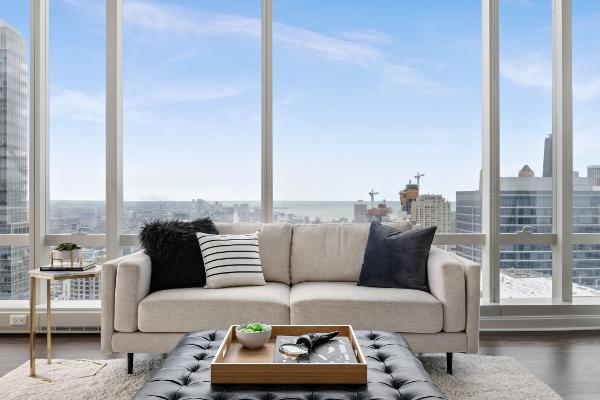Never Underestimate the Impact of Room Acoustics on Sound Quality

Today, our (Man-?) caves offer far more opportunity to get things right. I was reminded of that by a recent column in our sister publication, Stereophile. The writer was invited to audition a friend's system in the wilds of Manhattan. There was no in-depth description of the room itself, but it was clear from the remarks that this was a space of ample size. The system in question was 2-channel and clearly very high-end.
The only clue to the room's acoustics came as the writer commented on the apartment's floor-to-ceiling windows, presumably with unobstructed views of the city. The photo above is shown only as an extreme example of such a design, but is not the space referred to here. The mention of floor-to-ceiling windows, however, was a clue for me. There were no further details given on the room. Were there substantial drapes that could be drawn over the windows? Was the floor bare wood or tile, carpeted, or partially covered with rugs? The writer didn't say.
After listening, the advice offered was that the current cables might be holding the system back. The owner took that to heart and subsequently invested more on new cables than most of us have on our entire system. That's not a criticism but I have reservations about the need for platinum-priced cables. I do believe that good cables are important up to a point, but room acoustics are far more significant.
Yes, to a degree I speak with forked-tongue. Like most of you my room is hardly perfect. When I moved into a new house seven years ago my main consideration was that it would allow for both home theater (TV and projection) and 2-channel listening. With one side of the future multi-purpose space open to a kitchen/breakfast area, it wasn't ideal.
Nevertheless, it worked. A number of discretely-spaced acoustic panels in the main area (and other spaces to which it opens) helped, as did a thick, nearly room-sized rug over the hardwood floor (and the house's concrete slab foundation). At first I wondered if the heavy rug was sufficient for damping reflections from the otherwise bare floor, so I bought enough felt (not foam) carpet padding to install under the rug. I didn't like the result, so the felt was soon removed. It's now in storage waiting to become part of a long-delayed DIY bass trap. I'm not sure if the latter will help with the room's annoying bass mode from 100-200Hz. I often refer to the latter in my reviews, and can tame it only with room EQ below 300Hz.
Then there's the room's weird ceiling, looking like the underside of a 4-sided pyramid roughly 2-feet higher (estimated) at its apex than at the sides! Combined with the open space concept and the covered floor, this tends to diffuse the buildup of any audible high frequency "zing." The ceiling does work against upward-reflecting Dolby Atmos speakers, which is why I've installed four small overhead speakers high on the sides of the room (on the wall, not in the wall) just below where the "pyramid" starts to angle upwards. (It's also possible that upward firing Atmos speakers could work where the ceiling is uneven but identically so above each upward-firing speaker, as it is in my room.)
If at all possible you shouldn't position your listening seats hard up against a wall behind them. Reflections off the wall, and directly into your ears, can confuse and degrade the sound. As can reflections from a low coffee table between your seat(s) and the speakers!
My listening seats are several feet out from the wall behind them, a wall covered by shelves overflowing with books and video discs. Video disc cases aren't particularly absorptive, but to create at least a bit of diffusion there I've slightly staggered the acoustic depth of the shelves. I did this by placing 2x4s, either upright or flat, behind the discs on some of the shelves. On other shelves there are no 2x4 spacers at all. The IKEA shelves are roughly 3.5-inches deeper than a Blu-ray case; when the 2x4 sits flat behind the discs, the front of the discs sit flush with the front of the shelf. When a 2x4 isn't used, the discs sit fully back in the shelf. When the 2x4 is used upright, the discs on that shelf are in a middle position. You can, of course, do this without the spacer trick, but you'll spend a lot of time trying to keep the disc cases neatly, lined up!
Even experienced audiophiles tend to get wrapped up in the gear itself, reaching first for a shiny new toy that will solve their audio issues and improve their audio enjoyment. It's a natural reaction. Sometimes it works, as with adding a subwoofer offering EQ to tame low-frequency room modes, or new main speakers with dispersion qualities and frequency response deviations that better match your room acoustics. But sometimes making changes to the room itself can produce better results and keep you from wandering off into endless upgrades.





























































